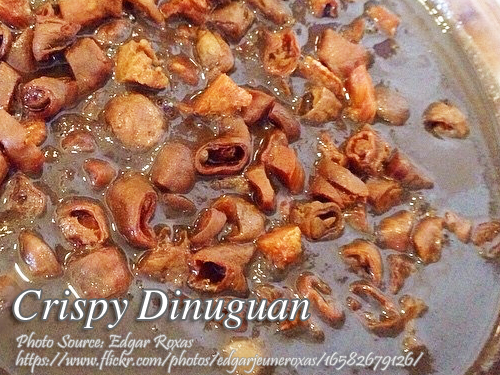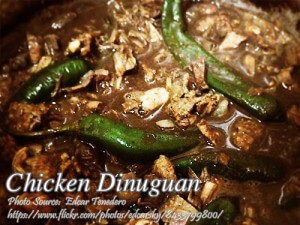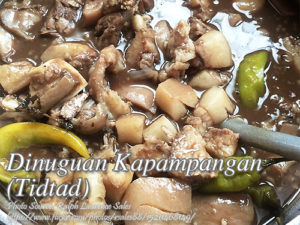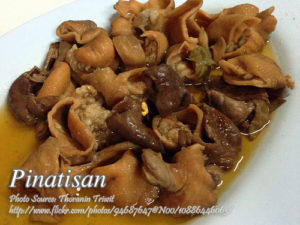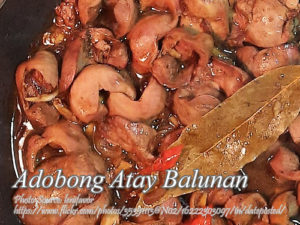There are many ways of cooking the dish. In this version of crispy dinuguan, you have to boil the intestines to remove the unpleasant odor and to make it crispy when fried. Then the pork, heart and liver is sauteed for a minute, then simmered with water, vinegar and spices until the meat is tender.
Then pour the pork blood afterwards and cook until the consistency is thick. You can either mix the crispy intestines while cooking the blood or you can put it as garnishing. I prefer putting it as a garnishing to make it look more appetizing. Best served with steamed rice or white puto.
Crispy Dinuguan: A Filipino Classic with a Crispy Twist
Dinuguan is a dish that evokes both nostalgia and excitement. Growing up, I remember how my Tita Aida would gather the family for lunch, and nothing brought us together like her Dinuguan. But this version—Crispy Dinuguan—is a step above. With crispy pork intestines adding a delightful crunch, this dish elevates the traditional dinuguan to something special. It’s perfect for those who are feeling a little adventurous or want to impress guests with a different take on this beloved Filipino classic.
A Dish Rooted in Tradition
Dinuguan, also known as blood stew, may seem intimidating to those unfamiliar with its ingredients. At its core, it’s a savory stew made with pork meat and offal, simmered in a tangy vinegar and pork blood sauce. The dish has its roots in the early Filipino cooking traditions, where no part of the animal was wasted. In fact, the term dinuguan comes from the word dugo, meaning blood, which is one of the key ingredients.
Every region has its version, from the spicier Bicolano dinuguan to the slightly sweet Batangueño take. But in my family, this Crispy Dinuguan is the star. It was my uncle, Tito Jun, who suggested frying the intestines to give the dish a crispy texture, and since then, we never looked back. It’s a game-changer!
The Secret to Crispy Intestines
One of the most important steps in this recipe is boiling the intestines first. As a child, I remember my cousins and I watching my grandmother meticulously clean and boil the pork intestines. This step not only removes any unwanted odor but also preps them for frying. When fried, these intestines turn into golden, crispy strips that add an irresistible crunch to the dish.
The trick to making them perfectly crispy? Patience. You have to stir-fry them on medium heat and make sure the oil is just the right temperature—not too hot, or they’ll burn, but not too low, or they’ll turn soggy. My cousin Marites, who often helped my grandmother in the kitchen, would always say, “Kailangan maingat ka sa apoy.” (You need to be careful with the heat.) And she was right. Perfectly crispy intestines are worth the extra attention.
Building Flavor with Sauteing
Once your intestines are crispy and set aside, it’s time to build the flavor base of the dish. In the same pan, you’ll want to sauté the garlic, onions, pork fat, and pork meat. There’s something about the smell of garlic and onions sizzling in the pan that instantly brings me back to my childhood. My Lola Linda would often say, “Amoy pa lang, nakakagutom na.” (The smell alone is enough to make you hungry.)
The brief sauté helps to release the rich flavors from the pork fat and meat. After just a minute, you add the internal organs, except for the crispy intestines, and allow them to absorb the aromatics. The offal, particularly the liver and heart, give this dish its deep, earthy flavor, which contrasts beautifully with the vinegar and blood later on.
Vinegar: The Key to Balance
One of the most important ingredients in dinuguan is vinegar. Its sharpness cuts through the richness of the pork and blood, balancing the dish with a tangy undertone. The key to making the vinegar work its magic is to let it simmer without stirring. My mother, who made the best adobo in the world, taught me this trick. She used to say, “Hayaan mo munang kumulo ang suka bago haluin.” (Let the vinegar boil before stirring.) This prevents the dish from having a harsh, overpowering vinegar taste.
Once the vinegar has boiled down and the meat is tender, you’ll notice that the dish starts to come together. At this point, I always take a quick taste to check the balance of the flavors. If it’s too tangy, a pinch of sugar can help mellow it out without making the dish sweet.
The Perfect Finish: Pork Blood
Finally, the star ingredient—pork blood—gets added to the wok. This is where things get really interesting. You’ll want to pour the blood in slowly, constantly stirring to avoid any clumps. The goal is to achieve a thick, smooth consistency. When done right, the blood thickens into a velvety sauce that coats every piece of pork.
Some people might shy away from the idea of cooking with blood, but trust me—once you try it, you’ll understand why this dish has been a Filipino favorite for generations. The blood adds depth, creating a savory, slightly metallic taste that pairs beautifully with the vinegar and spices.
Crispy Intestines as the Ultimate Garnish
At this point, you could mix the crispy intestines into the stew, but I prefer to use them as a garnish. There’s something so satisfying about that first bite—soft, flavorful pork, followed by the crunch of crispy intestines. My siblings and I would always fight over who got the last piece of crispy intestines. It adds an element of texture that makes this version of dinuguan stand out from the rest.
Serve this dish with steamed rice or, if you want to go the traditional route, white puto. The slightly sweet rice cakes complement the savory richness of the dish perfectly. And if you’re feeling bold, a couple of green chili peppers can give the dish an extra kick.
A Nostalgic Family Favorite
For me, Crispy Dinuguan isn’t just food—it’s a connection to my family, our heritage, and our shared meals. Each time I make it, I think of my Lola in the kitchen, my cousins waiting for the crispy intestines, and my uncle giving his tips on making the perfect dinuguan. It’s a dish that’s rich not only in flavor but in memories.
If you’ve never tried making dinuguan before, don’t be intimidated. With a little patience and love, you’ll be able to recreate this Filipino classic. And who knows—maybe it’ll become a favorite in your household, too.
How to Cook Crispy Dinuguan
Ingredients
- 1/2 kilo pork meat and pork fat
- 1/2 kilo internal organs including heart and liver
- 1/2 kilo intestines
- 3 to 4 cups pork blood
- 1 tsp. sugar
- 1 tsp. salt
- 1/2 cup vinegar
- 4 cloves garlic crushed
- 1 pc chopped onion
- 1 tsp black pepper
- 2 to 3 pcs green chili
- cooking oil for frying and sauteing
Instructions
How to cook Crispy Dinuguan Recipe
- After boiling the internal organs, slice into long strips. Separate the intestines.
- In a pan or wok, pour the cooking oil and put the intestines. Stir fry occasionally until it becomes crispy.
- Remove the crispy intestines from the wok and set aside.
- Remove also some of the cooking oil from the pan and leave only about 1 tablespoon.
- Saute the garlic, onion, pork fat and pork meat.
- After about 1 minute, put the internal organs except the crispy intestines.
- Then pour the vinegar, pepper, and a small amount of water and simmer until the meat is tender.
- When the liquid has evaporated and almost dry, pour the pork blood in the wok.
- Stir constantly until the bloods consistency becomes thick. Put the green chili peppers.
- Add sugar and salt to improve the taste and don't forget to add the crispy intestines before serving.
Notes
Cooking Tips:
Properly Clean and Boil the Intestines
Before frying the pork intestines, make sure to clean them thoroughly to remove any unwanted odor. Boiling them not only helps with cleanliness but also tenderizes the intestines, making them easier to fry to a perfect crisp. This step is crucial for achieving that signature crunchy texture that sets Crispy Dinuguan apart.Let the Vinegar Simmer Unstirred
When you add vinegar to the stew, allow it to boil without stirring to avoid a harsh, sour taste. This technique allows the vinegar to mellow and blend well with the other ingredients. Stirring too soon can lock in the raw vinegar flavor, which may overpower the dish.Stir Constantly When Adding Pork Blood
Once you pour in the pork blood, make sure to stir continuously to prevent it from clumping. Consistent stirring helps achieve a smooth, thick consistency that will coat the meat evenly. This step is key to getting the rich, velvety sauce that makes the dish so delicious.
